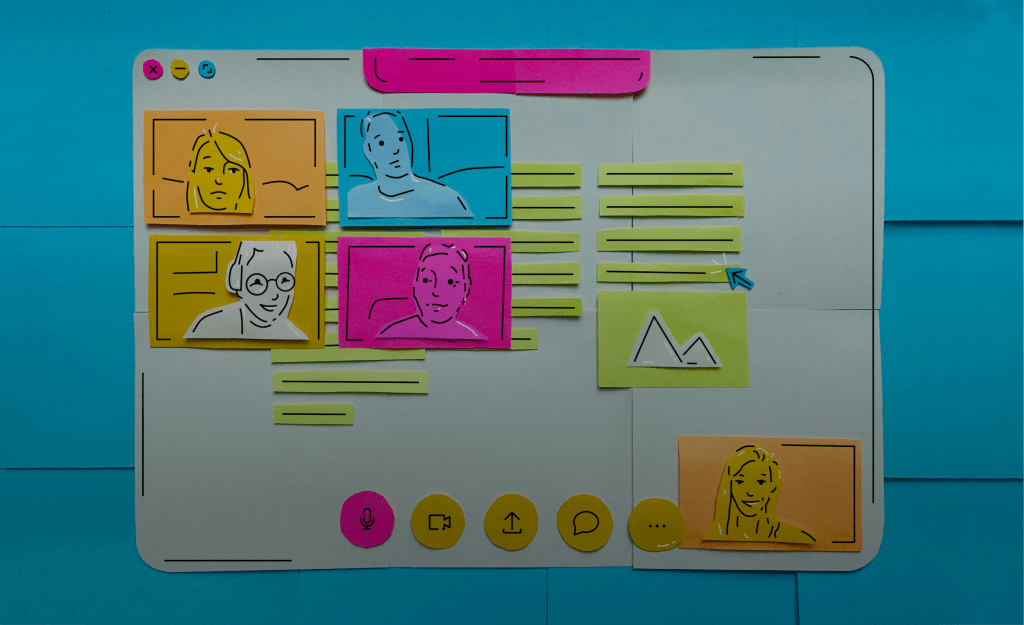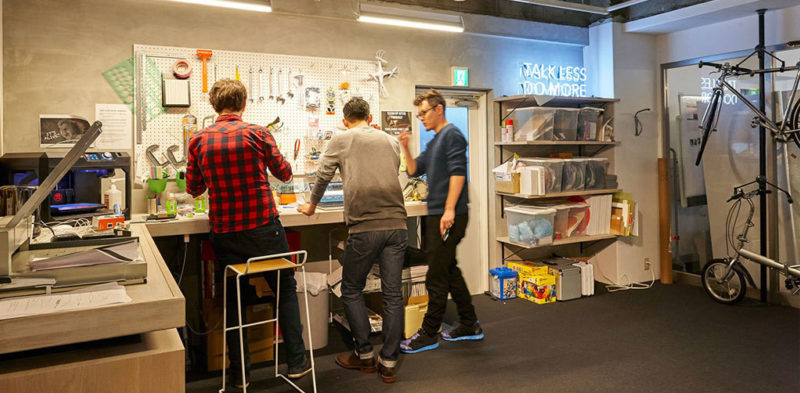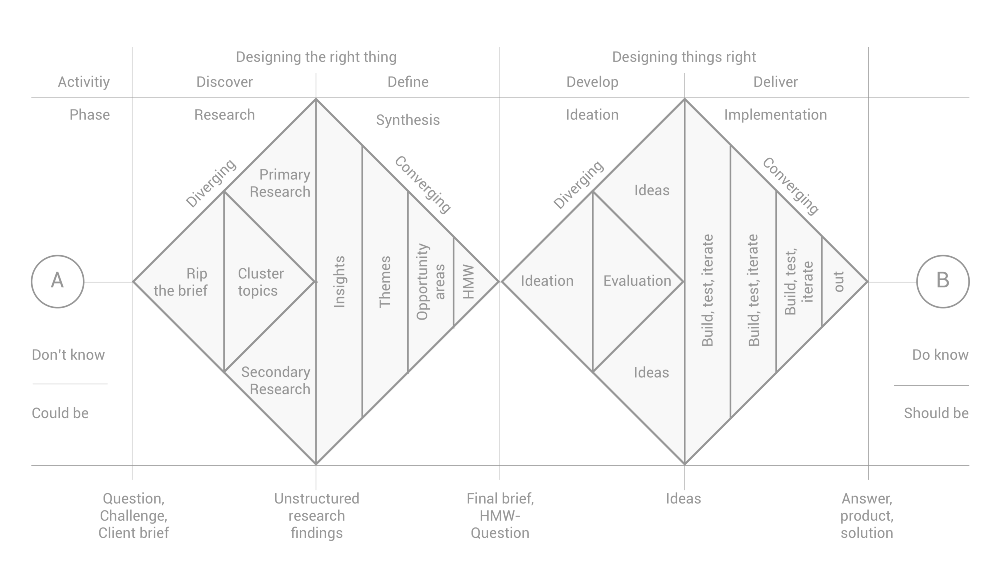Research has proven that companies who consistently use design thinking drastically increase their revenue.[1] But it’s still exceedingly rare in most organizations. Whether you’re a designer or a business major, when you hear about “design thinking” it tends to feel pretty abstract. It can be hard to get a simple definition out of someone, let alone concrete directions for taking actionable steps!
A Lack of Definition
While researching for this article, I was extremely disappointed by what I found. The majority of resources on design thinking are brutally esoteric. They’re jam-packed with lofty ideals and vague theory. It’s more like listening to lecture on the Elements and Principles of Design than getting practical business advice.
I can’t blame anyone for putting this stuff out there. Design thinking is a relatively nebulous and new concept.
I’m truly grateful to the professionals and organizations helping to define these uncharted waters of design, but I think we can do better.
Why Design Thinking Matters
I’m lucky to have years of experience designing for a wide range of companies, from a multi-billion-dollar Fortune 10 juggernaut, to a successful software startup with millions in venture capital backing. During this time, I have seen the compounding effects of design thinking (or a lack of it) first-hand.
When design thinking is in short supply, strategies quickly become misaligned, employees get lost in the swirl, and opportunities are missed. When design thinking flourishes, people flourish along with it. Expectations are clear, progress gets made, and goals are achieved.
I doubt many people actively dislike ‘design thinking’. More likely, it’s gets underused when professionals don’t really understand what it is, how it works, or where to start. Together, you and I are going to fix that.
My Promise to You
By the end of this article I promise you’ll walk away with three things:
- A simple definition of “design thinking”.
- A working knowledge of the most important aspects about design thinking.
- Actionable steps for implementing design thinking processes yourself.
Sound like a deal?
Good. Let’s get to it.
So, What is Design Thinking?
Simply put, Design Thinking is an analytical and repeatable process for creatively identifying and solving problems.

It honestly doesn’t have to be harder than that. Now, turning that definition into an actual framework with concrete steps – that’s where most resources fall flat. First, I’m going to work into this framework by covering the main aspects of design thinking. Then we’ll look at some big companies successfully using it today, and finish with some concrete steps for leveraging these processes immediately in your own work.
The Big 3 of Design Thinking
Design Thinking is the exact opposite of an ‘if we build it, they will come’ attitude. Instead, it goes hand-in-hand with a human-centered approach to design. They both prioritize empathy, iteration, and feedback loops. These are the ‘big 3’ main aspects of the design thinking mindset.
- Empathy. The most important factor when making something is whoever (or whatever) that particular thing is being made for. The team that’s making this thing will take time to objectively research and fully understand their users.
- Iteration. Failure isn’t commendable, but should be expected. A big swing that got lucky is less admirable than learning from small misses and consistently improving over time. Build, learn, repeat.
- Feedback Loop. Teams can’t learn without being informed. Feedback loops can be qualitative or quantitative, and they can come from a number of sources like usability testing or analytics. Basically, the feedback loop gives actionable insights that inform decisions. This is often paired with clear objectives, goals, and KPIs (key performance indicators).
It can be hard for some organizations to adopt this mindset because it’s hard for traditional command-and-control bosses to stand out. In a design and user-centric culture, there’s not much room for a leader to go all-in on intuition alone, get lucky, and come out the other side looking like a genius. It just doesn’t work that way.
Still, many organizations have managed to make the hard sell. Let’s look at how a few notable companies are currently using design thinking to drive innovation and change.
Design Thinking at IBM
IBM actually uses the term “Enterprise Design Thinking” to label its own bespoke framework for working with clients and solving problems for users. Notably, their design thinking approach has three key elements: Hills, Playback, and Sponsor Users.[2]

Hills are a user-centric value proposition, or essentially a large user story or epic. Playbacks are the structured gathering and review of observations and findings which yield insights. Lastly, Sponsor Users are outside individuals (not employees) who are representative of the target audience and are brought into the fold to collaborate with the team on summiting[sic] a particular Hill.
With these key elements, IBM adheres to their design process: Empathy > Define > Ideate > Prototype > Test
At the end of the day, the design team at IBM treats everything they deliver like a prototype that will be iterated on. In turn, this acceptance of change opens them up to innovation.
Design Thinking at IDEO
IDEO, on the other hand, takes a slightly different approach. IDEO sees design thinking as the intersection between desirability, viability, and feasibility.
They push hard for human-centered solutions and have used this approach to tackle a range of problems from…
- How will we personalize healthcare?
- How can we design a better food system for tomorrow?
- How can we use AI to make things better for humans?

IDEO says, “We adopt a “beginner’s mind,” with the intent to remain open and curious, to assume nothing, and to see ambiguity as an opportunity.”
Design Thinking at SAP
SAP’s strategy really focuses on empathy, making it a priority to place themselves in the shoes of their clients’ customers.
And they use this strategy as a way to solve anything from complex business problems dealing with change management.

SAP delivers complete end-to-end solutions by introducing their clients to a toolkit of user-centered strategies and workshops, encouraging them to get outside the confines of their office to foster creativity and open-minded discussions.[3]
And it Really Drives Profits?
In a word, yes.
These companies, and many others, value design because it gas been proven to drive profits.[1]
Are you ready to start driving your own profits through innovation and change? Then let’s get you the tools you need.
A usable Design Thinking Framework
Placed on a scale of time, the design thinking process looks like a sideways diamond. The scope of ideas and decisions are small begin with, before they increase into a huge delta of possibilities. Then, various inputs and learnings narrow the scope again.
This diamond shape can repeat indefinitely. So let’s look at the practical application of this concept in agile and lean product development practices.
In this context, we actually get a double diamond. The double diamond works great for visualizing the design process in product development from problem to solution. Using terminology from the Scaled Agile Framework, the diamond on the left is your exploration, and the diamond on the right are your development sprints.

Originally coined by the British Design Council as a way to describe all design processes, the double diamond shows how product teams can successful determine what they should be building before deciding how to build it. While this may sound like an obvious thing to do, anyone who’s spent time building digital products knows how quickly technical considerations can overshadow user needs.
This example should resonate with anyone in the digital space, but the concept of repeating divergence and convergence ‘diamonds’ can be applied to literally anything!
A Design Thinking Framework to Solve Anything
- Start with your problem.
- Be ready to be wrong. It’s okay to learn and adjust. That’s kinda the whole point.
- Name your user(s). This is who, or what, you’re making something for.
- Make a hypothesis. This can be anything from ‘Users want Thing X because of Need Y’ to ‘I think our users might hate that image carousel.’
- Set goals. What will success look like? How can you measure it?
- Discover.
- Get out. Get in front of your users and test your assumptions.
- Understand. Get in the head of your users and understand their points of view. Find what makes them tick.
- Go big. This is an inexpensive time to gauge crazy ideas. Just make sure you model the scientific method and limit variables in your individual tests and research.
- Define.
- Synthesize. Compile your findings, identify patterns, and pull out reliable insights.
- More problems. You will inevitably come out with more questions and problems. Awesome! Feed these back through the system starting at number 1.
- Refine. Update your hypothesis and write a user-centered story (if it’s not already written that way).
- Develop
- Get creative. Use your updated hypothesis to conduct design sessions, workshops, and creative brainstorming.
- Be idealistic. Because someone has to, and the next phase brings a heavy dose of reality.
- Deliver
- Make it. Bring your creations to life using real systems and materials.
- Test it. Show it to your users and learn what’s working and what’s not.
- Repeat. Repeat these steps as necessary.
- Deliver it. Your work is never done, and you’ll have some more problems to add to the backlog, but your delivered work is now ‘out in the wild’.
Steps for Starting Out
In many cases, deep pockets will be the only thing that will allow you to spend substantial time in each of these phases. But this framework is easily scaled, both up and down.
For example, when you’re identifying new problems through the process, don’t be overwhelmed. Prioritize them by their estimated effort and impact, and only take the top candidates through the ‘design thinking’ system again.
Additionally, your discovery phase might be as simple as just talking to 4–6 acquaintances who roughly fit your target user group. Having a professionally-screened participant list certainly helps, but it’s not required.
Moreover, ‘getting creative’ doesn’t require you to hold full-blown workshops. If it’s only you, just get off your computer and sketch a little. Throw some PostIts up on the wall. See what happens.
If you are in a bigger enterprise with a sizable budget, the challenge can be claiming that money for your design-driven goals.
Sell the process to your leadership by talking about the business value first. Find realistic benchmark data, and bring it down to dollars and cents. Then bring it home by talking about specific actions that might be able to align the organization in a design thinking mindset to reach the measurable results you’re suggesting.
Driving Change Starts with You
History and research shows that successful businesses both large and small leverage design thinking to drive revenue results. Good design affects everything from good customer experiences to good employee experiences.
You can use this design thinking framework to solve just about any problem. Just remember to keep the big three in mind — empathize, iterate, get feedback — and use data to be a champion of a design-led process at your company.
A change in mindset can start with one person. And I think that person could be you.
What do you think? Got a question? Let me know how you liked the article and feel free to ask for pointers and clarification.
References
- “The business value of design.” McKinsey Quarterly. McKinsey & Company. 2018
- “Enterprise Design Thinking.” IBM Design. Visited September 2020.
- “Introduction to Design Thinking.” SAP User Experience Community. SAP. 2012
- “Design Thinking.” IDEO. Visited September 2020.